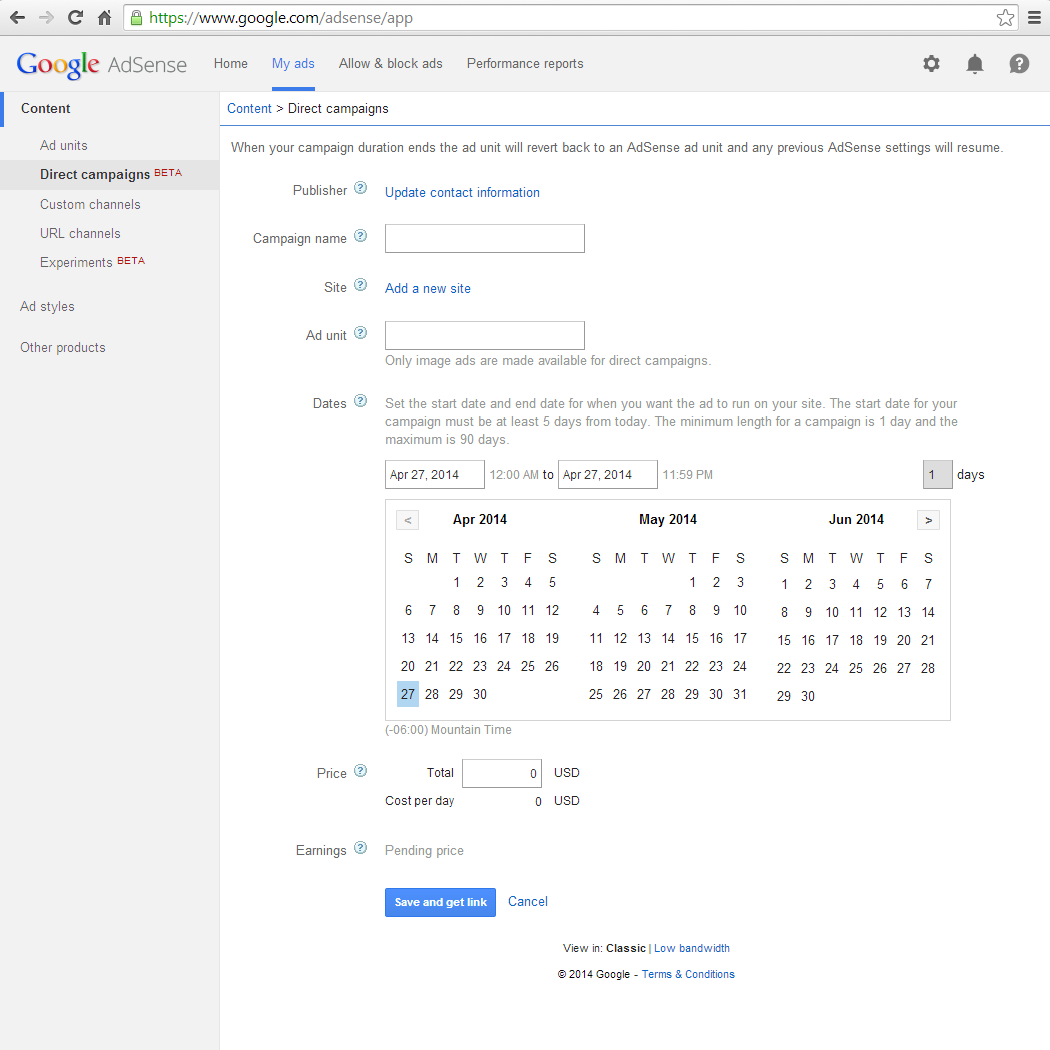Learning Center
Google AdSense Direct
We’ve begun receiving a number of questions regarding Google’s new AdSense feature titled, “AdSense Direct”. Following it’s launch into public beta on January 21, 2014, we’ve since spent some time using it and share with you our experience.
What is AdSense Direct?
AdSense Direct gives publishers the needed tools and guidance to negotiate and fulfill a direct advertiser ad campaign alongside their Google AdSense ad units.
In order to set up an AdSense Direct campaign, the publisher first creates a campaign from the ‘My Ads’ tab, assigns the campaign a website, a particular ad unit, a date range, and a fixed price for the given date range. Below is a screenshot of that interface.

The publisher then saves this campaign and receives a link to mail to the advertiser for review. Negotiations on price and date range may happen, at which time the campaign is adjusted until negotiations are final.
When the advertiser accepts the agreement, they insert their payment method (enter sales pitch for Google Wallet), then simply upload their ad creative and landing page URL using the link provided by the publisher via Google AdSense. The ad creative and landing page URL undergo a content and quality audit from Google before the ads are set live.
Finally, the ad goes live, runs the length of the campaign, and publishers are paid 85% of the negotiated total with their monthly AdSense earnings (Google retains 15% of the deal for their services). When the campaign ends, the publisher’s Google AdSense ads automatically take over to ensure ad serving is uninterrupted.
Here’s the short, video version:
Now… the questions.
Does AdSense Direct take the place of Google DFP for Small Business? Absolutely not. Google DFP for Small Business is a fully-featured ad server for handling multiple simultaneous campaigns from direct advertisers and third-party ad networks and exchanges. If you’re already using Google DFP, we recommend not bothering with AdSense Direct.
Does AdSense Direct compete with Google AdSense ads? No. AdSense Direct is the equivalent of a Sponsorship campaign (line item) in Google DFP for Small Business. Meaning, that the advertiser receives 100% of all impressions that ad unit generates for the given date range. If traffic goes up significantly one month, you may have been better off running Google AdSense ads than your AdSense Direct campaign.
Can advertisers run third-party ad tags through AdSense Direct? Likely no. Once negotiations are complete, the advertiser uploads their creative and landing page URL via a form generated from Google AdSense. Typically, a third-party ad tag will have a landing page URL embedded in the code, so the fact that Google is asking for a specific landing page URL tells us that the answer is likely no.
Summary
Our experience using Google AdSense Direct, although well executed, felt like taking a step backward from today’s more advanced programmatic buying services. This should have been a product Google launched in 2007 or 2009, not 2014. Direct ad sales are quickly becoming a thing of the past as more and more media buyers use large networks and ad exchanges to manage their media buys.
The only publishers we foresee using AdSense Direct are those publishers who rely heavily on local, direct ad sales. Any advertiser spending $500 or more per month would generally see a much better return on their ad spend via the technology and distribution an ad exchange or network can provide – at a fraction of the CPMs direct advertisers will demand.
Have you used AdSense Direct? We’re curious to know your experience with it and if you anticipate its continual use on your site. Post your thoughts and comments below.
Have further questions? Would you like us to elaborate on a particular subject? Ask your questions or request additional learning center content in the comments below.

0 Comments